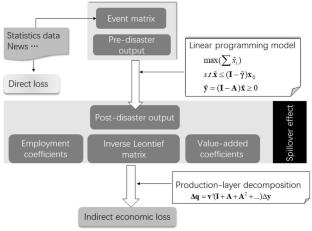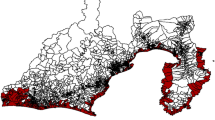Abstract
With the development of interregional trade, a potential disaster that happens in one place could cause enormous economic losses in distant areas. Timely and comprehensive post-disaster assessments play a significant role in guiding disaster recovery, and for reconstruction and planning for future disaster risk reduction. In this study, we evaluate the post-disaster economic impacts due to Sichuan earthquake in 2008 and its regional and industrial spillover effects based on a Chinese multi-regional input–output table. The results show that the 2008 Sichuan earthquake caused around 1725 billion US dollars of value-added losses and 69.9 million people of employment losses. The Chemical industry in Guangdong and Zhejiang suffered severe value-added losses due to indirect effects through supply chains. Furthermore, public administration in Henan, Sichuan, and Guangdong suffered large employment losses. In general, we find that the economically less developed provinces are more susceptible to larger losses compared to the economically developed provinces. The results in this study can provide information for decision-makers to devise effective solutions on how to release relief funds and for dividing adaptation plans to avoid serious economic losses due to future disasters.









Similar content being viewed by others
References
Albala-Bertrand JM (2013) Disasters and the networked economy. oxon, UK, Routledge.
Anderson CW, Santos JR, Haimes YY (2007) A risk-based input-output methodology for measuring the effects of the august 2003 northeast blackout. Econ Syst Res 19:183–204
Arto I, Andreoni V, Rueda Cantuche JM (2015) Global impacts of the automotive supply chain disruption following the Japanese earthquake of 2011. Econ Syst Res 27(3):306–323
Avelino AFT, Dall’Erba S (2019) Comparing the economic impact of natural disasters generated by different input-output models: an application to the 2007 chehalis river flood (WA). RISK ANAL 39:85–104
Bäumen SID, H, Többen J, Lenzen M, (2015) Labour forced impacts and production losses due to the 2013 flood in Germany. J HYDROL 527:142–150
Chen S (2011) Disaster impact and post disaster recovery and reconstruction: a case study of Wenchuan earthquake. China Literary History Press, Beijing
Cui P, Chen X, Zhu Y, Su F, Wei F, Han Y, Liu H, Zhuang J (2011) The Wenchuan Earthquake (May 12, 2008), Sichuan Province, China, and resulting geohazards. NAT HAZARDS 56:19–36
Dunford M, Li L (2011) Earthquake reconstruction in Wenchuan: Assessing the state overall plan and addressing the ‘forgotten phase’’.’ Appl Geogr 31:998–1009
Faturay F, Lenzen M, Nugraha K (2017) A new sub-national multi-region input-output database for Indonesia. Econ Syst Res 29:234–251
Faturay F, Sun YY, Dietzenbacher E, Malik A, Geschke A, Lenzen M (2019) Using virtual laboratories for disaster analysis- a case study of Taiwan, Economic Systems Research 1–26.
Geschkea A, Lenzen M, Kanemotoa K, Morana D (2011) AISHA: A tool to construct a series of contingency tables. http://www.iioa.org/conferences/19th/papers/files/273_20110528111_GeschkeLenzenKanemotoMoran_AISHA_fullpaper_final.pdf
Gourio F (2012) Disaster risk and business cycles. American Economic Review 102:2734–2766
Halkos G, Managi S, Tzeremes NG (2015) The effect of natural and man-made disasters on countries’ production efficiency. Journal of Economic Structures 4:10
Hallegatte S (2008) An adaptive regional input-output model and its application to the assessment of the economic cost of Katrina. RISK ANAL 28:779–799
He P, Ng TS, Su B (2017) Energy-economic recovery resilience with Input-Output linear programming models. Energy Economics 68:177–191
Huang R, Hubacek K, Feng K, Li X, Zhang C (2018) Re-examining embodied SO2 and CO2 emissions in China. SUSTAINABILITY 10:1505
Kajitani Y, Tatano H (2014) Estimation of production capacity loss rate after the great east Japan earthquake and tsunami in 2011. Econ Syst Res 26:13–38
Kajitani Y, Tatano H (2018) Applicability of a spatial computable general equilibrium model to assess the short-term economic impact of natural disasters. Econ Syst Res 30(3):289–312
Khosravi K, Shahabi H, Pham BT, Adamowski J, Shirzadi A, Pradhan B, Dou J, Ly H, Gróf G, Ho HL, Hong H, Chapi K, Prakash I (2019) A comparative assessment of flood susceptibility modeling using multi-criteria decision-making analysis and machine learning methods. J HYDROL 573:311–323
Koks EE, Thissen M (2016) A multiregional impact assessment model for disaster analysis. Econ Syst Res 28:429–449
Koks EE, Bočkarjova M, de Moel H, Aerts JCJH (2015a) Integrated direct and indirect flood risk modeling: development and sensitivity analysis. RISK ANAL 35:882–900
Koks EE, Carrera L, Jonkeren O, Aerts JCJH, Husby TG, Thissen M, Standardi G, Mysiak J (2015b) Regional disaster impact analysis: comparing input-output and computable general equilibrium models. Natural Hazards and Earth System Sciences Discussions 3:7053–7088
Koks EE, Thissen M, Alfieri L, De Moel H, Feyen L, Jongman B, Aerts JCJH (2019) The macroeconomic impacts of future river flooding in Europe. ENVIRON RES LETT 14:84042
Lee K, Lu S, Shih Y (2018) Contagion effect of natural disaster and financial crisis events on international stock markets. Journal of Risk and Financial Management 11:16
Lenzen M (2007) Structural path analysis of ecosystem networks. ECOL MODEL 200:334–342
Lenzen M, Kanemoto K, Moran D, Geschke A (2012) Mapping the structure of the world economy. ENVIRON SCI TECHNOL 46:8374–8381
Lenzen M, Geschke A, Abd Rahman MD, Xiao Y, Fry J, Reyes R, Dietzenbacher E, Inomata S, Kanemoto K, Los B, Moran D, Bäumen SID, H, Tukker A, Walmsley T, Wiedmann T, Wood R, Yamano N, (2017a) The global MRIO Lab-charting the world economy. Econ Syst Res 29:158–186
Lenzen M, Geschke A, Malik A, Fry J, Lane J, Wiedmann T, Kenway S, Hoang K, Cadogan-Cowper A (2017b) New multi-regional input-output databases for Australia-enabling timely and flexible regional analysis. Econ Syst Res 29:275–295
Lenzen M, Malik A, Kenway S, Daniels P, Lam KL, Geschke A (2019) Economic damage and spillovers from a tropical cyclone. NAT HAZARD EARTH SYS 19:137–151
Li J, Crawford-Brown D, Syddall M, Guan D (2013) Modeling imbalanced economic recovery following a natural disaster using input-output analysis. RISK ANAL 33(10):1908–1923
Lian C, Haimes YY (2006) Managing the risk of terrorism to interdependent infrastructure systems through the dynamic inoperability input-output model. Syst Eng 9:241–258
Liang S, Qu S, Xu M (2016) Betweenness-based method to identify critical transmission sectors for supply chain environmental pressure mitigation. ENVIRON SCI TECHNOL 50:1330–1337
Liu M, Wang L, Shi Z, Zhang Z, Zhang K, Shen J (2011) Mental health problems among children one-year after Sichuan earthquake in China: a follow-up study. PLOS ONE 6: e14706.
Mackenzie CA, Santos JR, Barker K (2012) Measuring changes in international production from a disruption: case study of the Japanese earthquake and tsunami. Int J Prod Econ 138:293–302
Mendoza-Tinoco D, Guan D, Zeng Z, Xia Y, Serrano A (2017) Flood footprint of the 2007 floods in the UK: the case of the Yorkshire and the Humber region. J Clean Prod 168:655–667
Mi Z, Meng J, Guan DB, Shan YL, Song ML, Wei YM, Liu Z, Hubacek K (2017) Chinese CO2 emission flows have reversed since the global financial crisis. NAT COMMUN 8:1712
Okuyama Y (2007) Economic modeling for disaster impact analysis: past, present, and future. Econ Syst Res 19:115–124
Okuyama Y (2014) Disaster and economic structural change: case study on the 1995 Kobe earthquake. Econ Syst Res 26:98–117
Okuyama Y, Sahin S (2009) Impact Estimation of Disasters: A Global Aggregate for 1960 to 2007. Policy Research Working Paper 4963, the World Bank.
Okuyama Y, Santos JR (2014) Disaster impact and input-output analysis. Econ Syst Res 26:1–12
Oosterhaven J, Bouwmeester MC (2016) A new approach to modeling the impact of disruptive events. J Reg Sci 56:583–595
Paraskevas A, Arendell B (2007) A strategic framework for terrorism prevention and mitigation in tourism destinations. Tour Manage 28:1560–1573
Peters GP, Hertwich EG (2006) Structural analysis of international trade environmental impacts of Norway. Econ Syst Res 18:155–181
Rose AZ (2009) A Framework for analyzing the total economic impacts of terrorist attacks and natural disasters. J Homel Secur Emerg Manage 6:1547–7355
Rose A, Liao SY (2005) Modeling regional economic resilience to disasters: a computable general equilibrium analysis of water service disruptions. J Reg Sci 45:75–112
Rose A, Wei D (2013) Estimating the economic consequences of a port shutdown: the special role of resilience. Econ Syst Res 25:212–232
Santos JR, Haimes YY (2004) Modeling the demand reduction input-output (i-o) inoperability due to terrorism of interconnected infrastructures1. RISK ANAL 24:1437–1451
Schulte in den Bäumen H, Moran D, Lenzen M, Cairns I, Steenge A (2014) How severe space weather can disrupt global supply chains. Nat Hazards Earth Syst Sci 14:2749–2759
Su B, Huang HC, Ang BW, Zhou P (2010) Input-output analysis of CO2 emissions embodied in trade: The effects of sector aggregation. Energy Economics 32:166–175
Tan L, Wu X, Xu Z, Li L (2019) Comprehensive economic loss assessment of disaster based on CGE model and IO model-A case study on Beijing"7.21 Rainstorm". INT J DISAST RISK RE 39: 101246.
Tirasirichai C, Enke D (2007) "Case study: applying a regional CGE model for estimation of indirect economic losses due to damaged highway bridges. Eng Econ 52:367–401
Tsuchiya S, Tatano H, Okada N (2007) Economic loss assessment due to railroad and highway disruptions. Econ Syst Res 19(2):147–162
Tukker A, Dietzenbacher E (2013) Global multiregional input output frameworks an introduction and outlook. Econ Syst Res 25:1–19
Wakiyama T, Lenzen M, Faturay F, Geschke A, Malik A, Fry J, Nansai K (2019) Responsibility for food loss from a regional supply-chain perspective. Resour Conserv Recycl 146:373–383
Wang Y (2017) An industrial ecology virtual framework for policy making in China. Econ Syst Res 29:252–274
Wang Y, Geschke A, Lenzen M (2015) Constructing a time series of nested multiregional input-output tables. Int Reg Sci Rev 40:476–499
Wang J, Zhang J, Gong L, Li Q, Zhou D (2018) Indirect seismic economic loss assessment and recovery evaluation using nighttime light images-application for Wenchuan earthquake. Nat Hazards Earth Syst Sci 18(12):3253–3266
Wei BY, Su GW (2016) Assessment on indirect economic loss of Wenchuan earthquake disaster based on input-output analysis. Seismology and Geology 38(4):1082–1094
Wu J, Ning L, Hallegatte S, Shi P, Hu A, Liu X (2012) Regional indirect economic impact evaluation of the 2008 wenchuan earthquake. Environ Earth Sci 65(1):161–172
Xia Y, Guan D, Jiang X, Peng L, Schroeder H, Zhang Q (2016) Assessment of socioeconomic costs to China’s air pollution. ATMOS ENVIRON 139:147–156
Xia Y, Guan D, Steenge AE, Dietzenbacher E, Meng J, Mendoza TD (2019) Assessing the economic impacts of it service shutdown during the York flood of 2015 in the UK. Proc Roy Soc A Math Phys Eng Sci 475(2224):20180871
Xie W, Li N, Wu JD, Liu XQ (2012) Evaluation of indirect loss from hypothetical catastrophes in two regions with different economic development levels in china. Nat Hazards Earth Syst Sci 12(11):3325–3335
Xie W, Li N, Wu JD, Hao XL (2014) Modeling the economic costs of disasters and recovery: analysis using a dynamic computable general equilibrium model. Nat Hazards Earth Syst Sci 14(4):757–772
Zeng Z, Guan D, Steenge AE, Xia Y, Mendoza-Tinoco D (2019) Flood footprint assessment: a new approach for flood-induced indirect economic impact measurement and post-flood recovery. J HYDROL 579:124204.
Acknowledgments
This work was supported by National Natural Science Foundation of China (41701615) Jiangsu Provincial Natural Science Foundation (BK20171038). The authors would like to thank the editors and anonymous reviewers for their constructive comments.
Author information
Authors and Affiliations
Corresponding author
Additional information
Publisher's Note
Springer Nature remains neutral with regard to jurisdictional claims in published maps and institutional affiliations.
Supplementary Information
Below is the link to the electronic supplementary material.
Rights and permissions
About this article
Cite this article
Huang, R., Malik, A., Lenzen, M. et al. Supply-chain impacts of Sichuan earthquake: a case study using disaster input–output analysis. Nat Hazards 110, 2227–2248 (2022). https://doi.org/10.1007/s11069-021-05034-8
Received:
Accepted:
Published:
Issue Date:
DOI: https://doi.org/10.1007/s11069-021-05034-8




